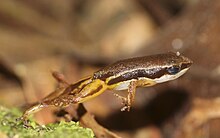frogs are amazing little creature with amazing skills some are poisonous, big, weird looking & etc
these are some photos:
Feet and legs
The structure of the feet and legs varies greatly among frog species, depending in part on whether they live primarily on the ground, in water, in trees, or in burrows. Frogs must be able to move quickly through their environment to catch prey and escape predators, and numerous adaptations help them do so.
Jumping
Frogs are generally recognized as exceptional jumpers, and the best jumper of all vertebrates. The Australian rocket frog, Litoria nasuta, can leap over 50 times its body length (5.5 cm), resulting in jumps of over 2 meters. The acceleration of the jump may be up to twice gravity. There are tremendous differences between species in jumping capability, but within a species, jump distance increases with increasing size, but relative jumping distance (body-lengths jumped) decreases
 |
Poison
Many frogs contain mild toxins that make them unpalatable to potential predators. For example, all toads have large poison glands—theparotoid glands—located behind the eyes, on the top of the head. Some frogs, such as some poison dart frogs, are especially toxic. The chemical makeup of toxins in frogs varies from irritants to hallucinogens, convulsants, nerve poisons, and vasoconstrictors. Many predators of frogs have adapted to tolerate high levels of these poisons. Others, including humans, may be severely affected.
Because frog toxins are extraordinarily diverse, they have raised the interest of biochemists as a "natural pharmacy". The alkaloid epibatidine, a painkiller 200 times more potent than morphine, is found in some species of poison dart frogs. Other chemicals isolated from the skin of frogs may offer resistance to HIV infection.
Life Cycle
eggs to tadpoles to young frog to frog


No comments:
Post a Comment